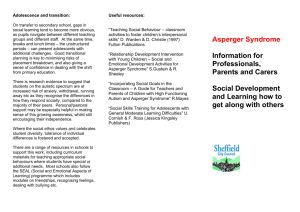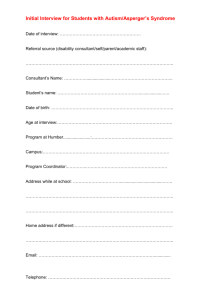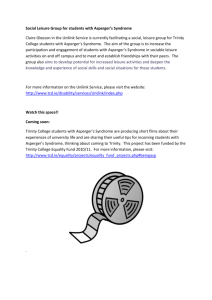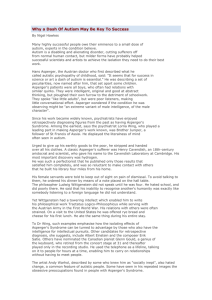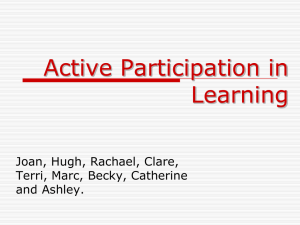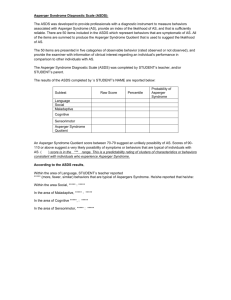document
advertisement
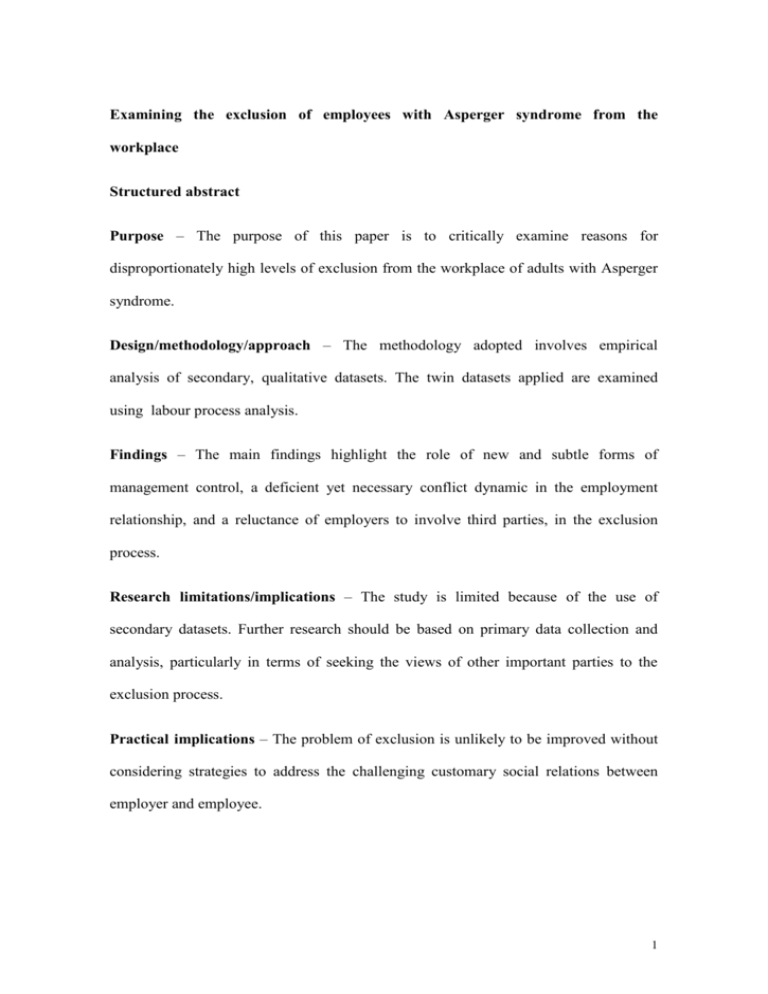
Examining the exclusion of employees with Asperger syndrome from the workplace Structured abstract Purpose – The purpose of this paper is to critically examine reasons for disproportionately high levels of exclusion from the workplace of adults with Asperger syndrome. Design/methodology/approach – The methodology adopted involves empirical analysis of secondary, qualitative datasets. The twin datasets applied are examined using labour process analysis. Findings – The main findings highlight the role of new and subtle forms of management control, a deficient yet necessary conflict dynamic in the employment relationship, and a reluctance of employers to involve third parties, in the exclusion process. Research limitations/implications – The study is limited because of the use of secondary datasets. Further research should be based on primary data collection and analysis, particularly in terms of seeking the views of other important parties to the exclusion process. Practical implications – The problem of exclusion is unlikely to be improved without considering strategies to address the challenging customary social relations between employer and employee. 1 Social implications: Improving employment inclusion is likely to reduce mental health problems for adults with Asperger syndrome and reduce the burden on those who play a broader supporting role. Originality/value: The topic of Asperger syndrome and employment has yet to permeate the academic literature on human resource management, employment relations and organisation studies. Key words: Employment; Asperger syndrome; Exclusion; Autism; Human resource management Paper classification: Research paper Introduction According to the National Autistic Society, Asperger syndrome is a form of autism, which is a lifelong disability that affects how a person makes sense of the world, processes information and relates to other people (National Autistic Society, 2011). Asperger syndrome is a ‘hidden disability’ caused by atypical neurology and from outward appearances it is impossible to tell that someone has the condition. A person with Asperger syndrome, moreover, is likely to have varying levels of difficulties with social interaction – widely known as a ‘triad of impairments’ (Wing and Gould, 1979). People with Asperger syndrome typically have social and emotional difficulties, problems with processing verbalised information, as well as difficulties with imagination. In an employment situation this could involve difficulties with teamworking, coping with office ‘banter’ and adapting to change. However, compared 2 to other forms of autism people with Asperger syndrome are often of average or above average intelligence and it is argued that with the right support and encouragement, adults with Asperger syndrome can live full and independent lives (National Autistic Society, 2011). Although arguably unique as a condition, the experiences of employees with Asperger syndrome mirror to a certain extent the experiences of people with mental health problems, both in terms of social manifestations of the condition and the general failure of employers to implement reasonable adjustments. For instance, as Seymour and Grove (2005) note, employees with mental health problems raise the concerns of employers through conditions such as depression, anxiety, personality disorders and manic depression. Further, as Biggs et al. (2010) suggest, employers are often put off employing people with a mental illness because of the need to provide excessive supervision, extra help following instructions and dealing with problems concerning poor socialisation. Despite such barriers to employment, the evidence suggests adults with mental health problems can also fully engage with competitive paid work if they are provided with right kind of support (Secker and Grove, 2005). Similar to the case of mental health and employment opportunity, it is believed that given the right support and encouragement adults with Asperger syndrome are capable of negotiating key employment-related social situations, such as job interviews, teamworking and the broader social conventions of work organisations (Attwood, 2007). Research suggests, however, that adults with a high-functioning form of autism, such as Asperger syndrome, are far more likely to be unemployed (80 per cent) when compared with adults who have a more recognised disability (50 per cent) (Barnard et al., 2001). Moreover, it has been said that the main consequence of neglecting the needs of adults 3 with Asperger syndrome when seeking employment is not just felt in terms of missing out on a pool of particular talent (National Autistic Society, 2004 and 2005), it is the far higher costs of treating secondary mental health problems due to exclusion (Meyer, 2001; Jarbrink et al., 2007). Estimates suggest there are around 300,000 adults in the UK with high functioning forms of autism, such as Asperger syndrome (Barnard et al., 2001) and, in this sense, represents a significant and often invisible burden on society. Yet, as argued by Roulstone (2005), the extant literature on the emergent issue of high levels of workplace exclusion amongst adults with Asperger syndrome is not noted for an engagement with a mass of social science literature on the realities of employment and work organisations. Indeed, such an observation is in contradistinction to the study of mental health problems and the workplace (e.g. see Seymour and Grove, 2005) and the much broader study of all disabilities in relation to the workplace (e.g. see Roulstone and Barnes, 2005). As such, the main aim of this paper is to further relate the problems of exclusion to the critical literature on employment and work organisations. To respond to the research aim set out above, the paper is organised as follows. First, there is a brief discussion of the existing, limited literature that describes why an extraordinary proportion of adults with Asperger syndrome come to be excluded from the workplace. In the second section, the analytical and methodological framework used in the current research is outlined and discussed. The analysis is presented in the third and fourth sections, divided into a presentation of the data from the two datasets, followed by an overall discussion of the findings. Identifying explanations for the exclusion of adults with Asperger syndrome from the workplace 4 The following section is based around a discussion of pre-identified explanations for the exclusion of adults with Asperger syndrome from the workplace. The explanations emerged from the analysis of a relatively small body of literature that concerns itself with employment and Asperger syndrome. The literature search identified 26 resources in total – 13 academic journal articles (none related to human resource management), three reports (funded by academic and/or charity-related funding), and 10 books (typically written by lay experts on Asperger syndrome). The categorisation process identified four ways by which we can begin to develop our understandings of the exclusion process: the condition of Asperger syndrome; transition from education to employment; external and internal support-related failures and the nature of work and employment. The purpose of this section is to establish what is broadly known about the exclusion process to pave the way for further, context specific and more critical investigations into this highly complex and problematic phenomenon. The manifestation of Asperger syndrome in the workplace Other than examples briefly discussed so far, it is apparent that numerous workplacerelated problems can arise because of the condition of Asperger syndrome. Examples of such problems include a higher than usual propensity for the employee to lose his or her temper, to be viewed by colleagues as arrogant and have difficulties asking for help and being assertive (Meyer, 2001). Moreover, many employees with Asperger syndrome have a sensory system that makes it difficult to cope with everyday workplace sensations, such as office chatter or flickering strip-lighting (Grandin and Duffy, 2004). Employees with Asperger syndrome are also likely to require very clear, comprehensive and linear instructions (Fast, 2004) and take a literal view of the contract of employment (National Autistic Society, 2005). Further problems directly associated with Asperger 5 syndrome include, as Johnson (2005) puts it, being ‘virtually oblivious of office politics’. Such employees can also become victims of workplace teasing whilst often blaming others in conflict situations (Attwood, 2007). A final common social manifestation of Asperger syndrome in the workplace involves extreme measures taken by the employee when under pressure or over-sensitised, such as sudden absence or resigning without warning (Hendrickx, 2008a). As such, unless a key member of staff is aware of social manifestations of Asperger syndrome, then social manifestations are likely to be viewed by managers and co-workers as odd and unwelcome in the workplace. Transition from full-time education to the workplace For some key writers associated with this specialist sub-field, the beginning of the exclusion process relates to the end of the individual’s full-time education. Generally, this side of the problem concerns making the transition from a stable educational environment to competing in far less predictable labour markets and adjusting to workplace routines that differ markedly from official accounts. Indeed, it has been argued by Patterson and Rafferty (2001) that there has been a widespread failure of mainstream schools to adjust generic transfer models to suit the unique needs of adolescents with Asperger syndrome. More broadly, the quality of life for adolescents with Asperger syndrome can decline sharply once the support mechanisms in place at school are removed (Jennes-Coussens et al., 2006). Leaving school tends to lead to an abrupt end of a particular type of specialist and social support and a new era often defined by a deficient or non-existent equivalent. It would seem that continued and progressive efforts to ensure that children with Asperger syndrome achieve educational 6 goals similar to their neuro-typical peers is not replaced by an equally effective and resourced employment-related equivalent on departing full-time education. Workplace support for the employee with Asperger syndrome A third area of concern relates more generally to appropriateness, availability and funding of specialist employment support, although it should be acknowledged that many work organisations have never employed to their knowledge, and have no precedents in employing or helping with the transition of, a person with Asperger syndrome (Hawkins, 2008; Austin et al., 2008). Further, as Nesbitt (2000) suggests, where there is precedent employers often hand the burden of identifying support to the individual rather than seeking specialist advice. For instance, in one sense there is a great deal of research that reports on the economic and therapeutic gain of specialist employment support initiatives (Gilson, 1998; Mawhood and Howlin, 1999; Nesbitt, 2000; Howlin et al., 2004; Schaller and Yang, 2005; Lattimore et al., 2006; GarciaVillamisar and Hughes, 2007; Jarbrink et al., 2007; Palmen et al., 2010). Conversely, there appears to be a rather large gap between the demand for specialist support and the supply of specialist support. Indeed, even the National Autistic Society (2005) reports that Prospects, its employment support service, can only deal with a minority of the many thousands of requests for help and guidance. Estimates of the shortfall in specialist employment support suggest around 10 per cent receive support at the interview stage and around 20 per cent receive some sort of specialist support when in employment (Beardon and Edmonds, 2007). A further dimension to this particular side of exclusion is that it is often claimed that support is unfit for purpose because, as Fast (2004) suggests, the needs of people with 7 Asperger syndrome do not compare well with the needs of the usual disability population. For example, research has found that support rarely recognises the unique, on-the-job training needs of such people (Lattimore et al., 2006; Palmen et al., 2010). The outcome is support that tends to overlook the high intellectual capability of people with Asperger syndrome (Mawhood and Howlin, 1999; Schaller and Yang, 2005) and where specialist employment services exist there is also a propensity to treat all people with Asperger syndrome as an homogenous group (Hendrickx, 2008a). There is also evidence that employment specialists are in the habit of having an overly narrow and stereotypical understanding of the jobs and careers to which adults with Asperger syndrome are capable of aspiring (Fast, 2004). It has even been suggested that specialist charities or other voluntary organisations are often equally ill-equipped at coping with the employment-related needs of adults with Asperger syndrome (Hawkins, 2004; Hendrickx, 2008a). As such, it could be said that the exclusions process is exacerbated by a general lack of understanding, support, respect and appropriate services (Bliss and Edmonds, 2008). The nature of employment and work organisations A fourth side to the exclusion process concerns the main context of the problem. Indeed, a great deal of what emerges from the literature suggests, according to Meyer (2001), that people with Asperger syndrome are in many ways unanticipated and uninvited guests in most work organisations. There is also evidence to suggest many employers simply do not see people with Asperger syndrome as employable (Austin et al., 2008). This particular side to the problem, as many would expect, is multifarious. For instance, Fast (2004) generally sees the problem as finding a fit between the individual and the work organisation. Similar problems include intolerant bosses (Grandin and Duffy, 8 2004), the commonality and reliance upon ‘unwritten rules’ (National Autistic Society, 2005; Wilkinson, 2008), and not allowing sufficient time to process information in a manner that makes sense to the employee with Asperger syndrome (Bliss and Edmonds, 2008). The list goes on and this perspective on exclusion is by no means exhausted by the following range of problems related to the nature of employment and work organisations: the provision of poor job previews (Hendrickx, 2008a); a general lack of managerial or collegial tolerance for individual idiosyncrasies (Bliss and Edmonds, 2008); a failure to build on precedents of employing people with Asperger syndrome (Nesbitt, 2000); employers’ inconsistent management of prospective employees disclosing details of their condition (Meyer, 2001); and employers claiming ignorance when challenged to make ‘reasonable adjustments’ under the Disability Discrimination Act (DDA) 1995 (Bliss and Edmonds, 2008; Graham, 2008). Taken together, there would appear to be little doubt that the nature of employment and work organisations play a pivotal part in exclusion, particularly in terms of setting up the individual to fail in employment situations. What is also apparent is how such problems are repeatedly described and not understood in the context of an analytical framework designed to cope with the realities of employment and work organisations. Analytical approaches to exploring exclusion In the absence of a body of literature that takes a critical view of the widespread exclusion of adults with Asperger syndrome, new entrants into this emergent sub-field of human resources management and employment studies are allowed a level of freedom in terms of electing an analytical approach. Further, recent studies that look at mental health problems and employment do not appear to be characterised by a particular employment-related analytical approach (e.g. Samson, 2004; Secker and 9 Grove, 2005; Seymour and Grove, 2005; Biggs et al., 2010). Labour process analysis will be used to facilitate a critical analytical approach to exploring the exclusion of adults with Asperger syndrome from the workplace. The rationale for this choice is explained as follows. Central to labour process analysis is recognition of a control imperative in the labour process, so that employers can release the power of labour and at the same time secure profits from labour (Thompson and Smith, 2000). How this relates to the problem of exclusion is summarised as follows. First, the labour process is said to involve a ‘struggle’ between employer and employee typically concerning, for example, the division of labour, possibilities for deskilling, and the separation of conception and execution (Bolton, 2005). The struggle, as argued some time ago by Edwards and Scullion (1982), is typically denoted by the social organisation of conflict leading to order and understandings between managers and non-managers. This approach is relevant, therefore, because no person operating in competitive employment markets is exempt from such customary struggles. Indeed, in this instance, the struggle is likely to be distinctive because of the typically limited social skills of the employee or prospective employee with Asperger syndrome. A second advantage of labour process analysis is its adaptability to ‘new realities’ of the workplace (Thompson and Smith, 2010). It is clear that employers having to make reasonable adjustments for employees with hidden disabilities represent a very new workplace reality, especially as the previous section highlights how difficult it appears to come to a level of order and understanding between manager and employee with Asperger syndrome. Thirdly, as Bolton (2005) suggests, labour process analysis considers the extent to which groups, when subject to employer attempts to control the labour process are able, via resistance, 10 to re-make the world in small ways. In other words, any attempt to explore why employees and prospective employees with Asperger syndrome have problems acquiring and holding down competitive employment must be prepared to use an analytical framework that is efficient at teasing out why it is especially hard for employees with Asperger syndrome to bring about the small changes required to make employment tolerable and, to an extent, fulfilling. More specifically, in this paper, labour process analysis will be used to examine situations that play a significant part in the exclusion process. These situations preidentified in the data include the selection process, everyday people management, the physical and social working environment and employer reticence and resistance towards workplace support. All four categories represent key points at which problems can occur and the point at which the exclusion may start or intensify. Methodological approach Empirical studies typified by labour process analysis are often characterised by the use of rich and colourful qualitative data (Ackroyd and Thompson, 1999). As such, in keeping with labour process analysis traditions and conventions, the method adopted for the current research involves empirical analysis of secondary qualitative datasets or interpretations, conclusions or knowledge additional to or different from those presented in the first inquiries (Hakim, 1982). Data used in this paper comes from two sources – a national report on the broader needs of adults with Asperger syndrome by Luke Beardon and Genevieve Edmonds (2007) and the findings from a similar study by Sarah Hendrickx (2008a). More specifically, data is recycled from qualitative research where adults with Asperger syndrome are, amongst many things, allowed to report and reflect 11 on employment experiences. Study one (Beardon and Edmonds, 2007) involved the gathering of 237 questionnaires by adults with Asperger syndrome, with employment representing just one of many issues tackled as part of a much wider research project and policy shaping initiative. The sample was drawn from attendees of a nationwide consultation event (Manchester, UK, 27 April 2006), with approximately 80 per cent of the participants having a formal diagnosis of Asperger syndrome. Further details of the sample are not mentioned in the report and the ratio of employed to unemployed is unknown or not stated, although the actual data suggests wide-scale experience of employment seeking and employment itself. An important reason to use data from the study relates to the fact that the consultation was believed to be the largest of its kind in the UK. Study two (Hendrickx, 2008a) is much smaller by comparison and is chosen because it targets employment problems. The data from this study is also noted for being rich and colourful. The sample for the second study is broadly similar to a book by the same author on adults with Asperger syndrome and personal relationships (Hendrickx, 2008b). The sample in question is based on semi-structured interviews with 25 individuals who either have a formal or a self-diagnosis of Asperger syndrome. The majority are male (22 in total) and range from 21 years to 75 years of age. It is important to note, however, that the vast majority of this sample has a job, which is somewhat different from the wider reality of adults with Asperger syndrome. The preference for adopting this methodological approach is based on a simple premise – a convenient, sufficiently large, wide-ranging and reliable amount of data has already been compiled by several researchers and it is plainly evident, even from a cursory consultation of the texts, that the two datasets allow the investigation of new and additional research questions (Heaton, 2004). 12 There are many advantages associated with an empirical analysis of secondary datasets. Many of the advantages associated with secondary analysis of datasets, such as low costs, time saving, minimal or no ancillary support required (Kiekcolt and Nathan, 1985) and using secondary data to verify findings already obtained in primary research by the investigator (Black and Champion, 1976), were not relevant in this instance. Instead, key factors far more salient include the fact that the secondary sources in question could be easily reanalysed from a different theoretical perspective (Dale et al., 1988 cited in Burton, 2000) and the data available is characterised by being closely related to the theme of the current research (Proctor, 1996). Further, it is an approach that allows access to individuals who are normally fairly inaccessible (Bryman, 1989). There are a range of factors, however, that require some degree of attention when applying empirical analysis of secondary sources. Relevant limiting factors include ethical issues raised when using secondary sources, in that there is a continuing need to maintain the anonymity of the research participants (Proctor, 1996). Datasets, as Bryman (1989) argues, do not usually survive the passage of time. It has also been argued that using more than one dataset reduces the overall reliability and validity of the findings (Burton, 2000) and that datasets should not be used just because of availability (Black and Champion, 1976). Furthermore, the secondary analyst often has to analyse larger volumes of data than the primary analyst (Hakim, 1982). To allow for such potentially limiting factors the data presented in the following section was selected on the basis of guaranteeing the anonymity afforded at the initial stage of data collection. Datasets were taken from current studies that reflect current employment and contemporary management realities, datasets were of similar quality and reliability and 13 working with the two datasets required only modest amounts of effort compared to singular analysis of one set of primary data. In terms of the analytical process, themes associated with labour process analysis, such as employer control and employee-employer conflict situations, were used to code the data and to provide an overall structure to the findings section. The findings section that follows is based on applying labour process analysis to explore the exclusion process in relation to management control apparent in work organisations. The main context of the exclusion process Exclusion through selection procedures According to the data, it is evident that selection procedures play a clear part in the exclusion process. The following examples extracted from the datasets are cases in point: I would love to get back to work, but all the application forms ask if I have a disability. I NEVER even get interviews now since diagnosis. Before I used to get a job within days, never mind an interview, since I have such a good CV! (Beardon and Edmonds, 2007: 137). …I’ve declared Asperger’s on application forms and the ones i have, I’ve never heard back from. I have also been bullied out of jobs, and subsequently, I’m afraid of applying for new jobs, lest I’m either bullied, or fired again. I don’t seem to be able to get a job where I have mentioned Asperger’s, so i feel I’ve no choice but to hide it (Beardon and Edmonds, 2007: 139). 14 In both situations, evidence attests to selection-related exclusion that arises from disclosure (Meyer, 2001) and employers being perceived to be reluctant to make reasonable adjustments for prospective employees who declare a pre-existing disability (Bliss and Edmonds, 2008; Graham, 2008). Then again, it is necessary to go beyond descriptive accounts of such forms of exclusion and aim to align empirical findings with an effective and relevant analytical framework. Indeed, as Thompson and McHugh (2009) note, selection is not a neutral procedure and should be seen as part of a wider and evolving strategy by management to control the labour process. Further, as suggested by Callaghan and Thompson (2002), the increased centrality of social skills and competencies has led to most employers adopting rigorous selection procedures for even low-skilled jobs. As such, there is also ample evidence from the datasets to see how recent developments in selection procedures, such as behaviour screening exercises related to competence based interviews and personality testing, appear to increase the likelihood of exclusion: …I have real difficulty in ‘competence based’ interviews. This is where interviewers demand instances of situations in which you have done ‘x’ and exactly what you have done to achieve ‘x’. I find that my memory simply does not keep records in this way… (Male, 60s, Hendrickx, 2008a: 106-107). The job interview is the worst, because you’re expected to put on this song and dance to garner their favour. I have to be VERY VERY VERY careful not to correct the interviewer’s mistakes or misconceptions, because doing that always guarantees that they don’t like me, and I won’t get the job. It’s always ‘Yes, sir, yes sir, three bags 15 full sir’, i.e. lying. And lying grates on me like nails on a chalkboard… (Male 30s, Hendrickx, 2008a: 108). The bottom line is that many jobs deliberately screen out Asperger's unwittingly. Personality tests ought to be illegal, it is a form of discrimination. We are not by nature suited to the sort of personality many unskilled and low skilled [employers] are looking for (Beardon and Edmonds, 2007: 147). What is evident here, moreover, is a sense of hopelessness, with prospective employees rendered powerless to resist or remake the situation in small ways (Bolton, 2005). Further, it is also apparent that more can be said here than simply suggesting that people with Asperger syndrome need more time to process what is expected of them (Bliss and Edmonds, 2008) and require more specialist support (National Autistic Society, 2005). What this suggests is that unlike in the case of neuro-typical employees, where some power or control is usually possible in selection or broader employment-related situations (Thompson and McHugh, 2009), taking some level of control of the situation is far less of an option for the prospective employee with Asperger syndrome. Exclusion and everyday people management As in the previous sub-section, no real depth of analysis is required to see that exclusion can occur as a result of the everyday management of people in the work organisation. Indeed, the following examples detail lived experiences of intolerant bosses (Grandin and Duffy, 2004) and intolerance for individual idiosyncrasies (Bliss and Edmonds, 2008): [I became] very confused and distressed by bullying, sarcasm and similar 'management' techniques (Beardon and Edmonds, 2007: 134). 16 They could actually ask me how they could help, not shun/exclude me and actually show some consideration (Beardon and Edmonds, 2007: 135). They didn’t try – they just fired me (Beardon and Edmonds, 2007: 136). There is also further evidence of employers, via line managers, taking the view that adults with Asperger syndrome should not be allowed to operate in competitive employment markets (Austin et al., 2008): My Manager knew of my disability but bullied me. She said people like me don't deserve to work. I was late sometimes because I was scared of her. I spoke to various employment advisors, but no-one would intervene to make her stop. I needed her to leave me alone, to not be so loud and to give me better lighting (there was not proper lighting in the room at all) and to not be 'in my face' all the time. (Beardon and Edmonds, 2007: 137). There is additional evidence for an over-reliance by managers on unwritten rules (National Autistic Society, 2005; Wilkinson, 2008) – in the following cases this relates to difficulties in recognising everyday aspects of the employment relationship that are rarely communicated in an overt and explicit fashion: The entire place was one massive mix of politics and infighting which I just couldn't comprehend and work my way round. I’m still not sure how I could have done better without turning into a total bastard like the boss, which isn’t my style (Male 40s, Hendrickx, 2008a: 35). I’ve been fired from every job I’ve had so far. In my first job, it was because they agreed the deal on me. I said I wouldn’t do sales, and they agreed. Later when things 17 got tough, they wanted me to go up to people and sell stuff to them. When I failed to do it to their satisfaction, they fired me. My boss was always hovering near me, checking to make sure I did no wrong…He fired me when I refused to sign a new contract that severely limited my rights, for less compensation (Male 30s, Hendrickx, 2008a: 36). Taken together, it can be seen how everyday experiences of people management can be highly distressing for the employee with Asperger syndrome but, also, in the longer term, how unattended distress could affirm or lead to acute mental health problems (Meyer, 2001; Jarbrink et al., 2007). It is also evident in the findings that employees with Asperger syndrome lack the necessary social skills required to assertively navigate the often complex company grievance procedures and make a stand against poor, confusing and arbitrary treatment. Pivotally, to what extent should we view this aspect of the problem as a fault of the individual and broader supporting actors and to what extent should we hold employers responsible? To answer this question, we need go no further than a broad body of literature that suggests neuro-typical employees are known to, for example, use humour in social situations to undermine management (Taylor and Bain, 2003), challenge power relations in meetings (Marra, 2007), as well as moderate various styles of leadership (Duncan and Feisal, 1989; Avolvio et al., 1999). As such, in the absence of customary social relations between employee and employer, where opportunities to challenge power are apparent, the employee with Asperger syndrome is largely defenceless when confronted with poor people management practices. Exclusion and the physical and social environment 18 A further dimension to the exclusion process involves an apparent conflict between the employee with Asperger syndrome and the physical and social environment of the workplace. For instance, the examples below demonstrate how employees with Asperger syndrome struggle to cope with the physical working environment: Fluorescent lights make me ill, also too much sounds, can’t follow conversations easy (Beardon and Edmonds, 2007: 131). [I] hate noise, but endured 10 years in an open plan staffroom, to my acute discomfort (Beardon and Edmonds, 2007: 132). I can’t stand inane tittle-tattle – I had some bad luck as we moved to open plan 18 months ago from individual (Dickensian) rooms so have asked for a small cell in away from the maddening crowd; I concentrate on the computer screen and thankfully much use of e-mails mean I often get away with not ‘phoning people – I can’t stand being overheard and the open plan makes this difficult (Beardon and Edmonds, 2007: 133-134). Flickering lights really drive me crazy unless I am totally focused on analysis or there is a critical situation I am managing (Male, 50s, Hendrickx, 2008a: 45). The following quotes demonstrate the unique social challenges faced by the employee with Asperger syndrome. Indeed, it can be seen how the employee with Asperger syndrome is unlikely to fall into an automatic or innate pattern of behaviour even when repeatedly exposed to forms of social interaction common to most contemporary work settings. Such social challenges include knowing what to say and do when faced with extra everyday social situations: 19 My job involves a lot of social entertaining, team events, large parties, noisy events, and I often find myself drifting to the edge and melting away, feeling very tired/drained (Male, 40s, Hendrickx, 2008a: 35). I always spend my lunchtimes on my own, reading newspapers and speaking to nobody if I can help it. This enables me to process what I have experienced and to prepare for the afternoon. Since giving up alcohol, I rarely socialise with work colleagues immediately after work. I prefer to go home and spend time on my own in my room (Male, 20s, Hendrickx, 2008a: 43). …I have had warnings in work for not being sociable and dealing with people via email instead of face to face (Beardon and Edmonds, 2007: 147). It can be seen in one sense how the underlying features of Asperger syndrome conflict with the expected organisational norms surrounding a willingness to be sociable with both customers and colleagues. In one sense at least, the findings, back up previous studies that highlight how workplace problems can be related to instances of sensory overload (Grandin and Duffy, 2004). By taking such an approach, however, it is not made clear that employers have the potential to exacerbate such situations. Indeed, in the realms of labour process analysis, both the physical and social environments of work organisations are by no means off the radar in terms of how employers attempt to control the labour process. By looking at such aspects of work organisations we are also likely to see a further side to missing customary social relations between employee and employer. For instance, Barnes (2007) believes the physical work environment (e.g. from the building, layout, furniture, equipment, décor and design, to lighting, temperature and air 20 quality) is not a neutral feature of the labour process and should be considered as part of the contested terrain between employee and employer. This is a broadly similar view to the stance taken by Houlihan (2002) who comments on increasing attempts by employers to shape and control the values of employees by creating modern and stateof-the-art workplaces. Specifically, conflict typically occurs in situations when employees become aggrieved by a lack of private space, or that the physical environment affects performance. However, employee resistance uncovered in Barnes’s (2007) study tended to be collectively organised, or at the very least characterised by socially astute individuals. Such findings are in keeping with many studies conducted on employee resistance in tightly controlled workplaces. In another sense, attempts have been made to conceptualise everyday socially-orientated aspects of work as subtle forms of management control. For example, Findlay et al. (2000) found the introduction of teamworking lead to increased positive attitudes and broader business awareness amongst employees. Similarly, Kinnie et al. (2000) found fun initiatives were implemented by a call centre to camouflage the factory-like nature of call centre work and help raise productivity and reduce short-term employee turnover. However, the reality of teamworking is that many employees end up feeling disillusioned and complaining of abuse of flexibility or intensification of work pressures (Findlay et al., 2000). Many fun at work initiatives, moreover, turn out to be about working hard and playing hard, as well as an expectancy to conform and play the part (Bolton and Houlihan, 2009). The outcome is that fun at work initiatives can create new tensions in the employee-employer relationship. However, from the datasets we see little evidence of employees with Asperger syndrome willing to challenge management prerogatives expressed through physical 21 and social forms of control and in many cases the datasets point towards very high levels of personal anxiety and distress caused in part by physical and social forms of employer control. In fact, the datasets suggests employees with Asperger syndrome appear overly resigned to not being able to do much about the conditions under which they are employed. What we are also seeing is how new forms of control cruelly expose the vulnerabilities of employees with Asperger syndrome. Such vulnerabilities are perhaps better understood in the apparent lack of customary social skills and marshalling of broader support to at least temper the pressures caused by such initiatives. As such, from this perspective, it helps reinforce the notion that future attempts to understand the problems of exclusion should be broadened to recognised new forms of management control. These attempts should consider how such forms of management control challenge the already fragile social skills of the employee with Asperger syndrome. Employer reticence and resistance towards workplace adjustments A final perspective on the exclusion process to emerge from the datasets relates to evidence of employer reticence and resistance towards making adjustments for employees with Asperger syndrome. Detailed below is evidence of an unhelpful attitude by employers towards agencies designed to support employees with Asperger syndrome in employment-related situations. The quotes below provide evidence of employers having a disproportionate say in whether such agencies should play a part in employeeemployer conflict situations: Employers could be more understanding, and more [accepting]. We NEED support workers, but as soon as you mention this, employers get put off (Beardon and Edmonds, 2007: 136, original written emphasis). 22 [Successful employment experiences require s]upport from a suitable agency which understands the nature of the disabilities I live with and the possible misunderstandings that can occur with employers. Then lots of patience and a listening ear when things go wrong! The ability to negotiate with me and the employer in this case (Beardon and Edmonds, 2007: 142). Employment advisors need powers to be able to intervene where there is bullying! (Beardon and Edmonds, 2007: 142). [I asked about] some reasonable adjustments, e.g. a technical buddy, a task list broken down into smaller steps, and awareness training for colleagues. It's been a bit patchy: a bit here, then nothing more for several months (Beardon and Edmonds, 2007: 128). The data in this instance could be reasonably interpreted as a cry for help. There is little evidence that the employees in question believe they possess the necessary social skills to make employers think differently about their particular workplace needs. There also seems little doubt that a great deal of needless suffering relates to employer reticence and resistance towards workplace adjustments. In another sense, there is evidence of external support failures and employers placing the burden of identifying adjustments on the employee with Asperger syndrome (Nesbit, 2000). There is also evidence of intolerant bosses (Fast, 2004) as well as varying levels of employer reluctance to consider adjustments under the Disability Discrimination Act (DDA) 1995 (Bliss and Edmonds, 2008; Graham, 2008). However, using a critical approach allows us to provide broader and more abstract understandings of the problem and play a part in increasing the rate of inclusion of employees in competitive employment. 23 It seems reasonable, first of all, to suggest employer reticence and resistance towards workplace adjustments recommended by third parties relates to broader trends in employer behaviour. For instance, over the past three decades the Workplace Employment Relations Series has clearly detailed a growing and ongoing employer reluctance to bargain and consult with employees and their representatives, particularly in the expanding private and small and medium-sized enterprise sectors (e.g. see Kersley et al., 2006). As such, it is not surprising to find that employees with Asperger syndrome have problems getting employers to recognise the necessity of specialist employment advisors, mainly because specialist advisors are likely to be viewed as intrusive by many contemporary employers. In more specific terms, there is also emergent evidence to suggest that British employers are not only increasingly keen to unilaterally set everyday terms and conditions of employment, they are similarly reluctant to negotiate with employees over adjustments related to an impairment or disability. Such reticence and resistance is evidenced in recent research, in that many employers lack formal procedures concerning adjustments for disabled employees (Foster and Fosh, 2010). In further current research it has also been found that employers are all too often caught in the habit of designing jobs that make insufficient allowance for difference (Foster and Wass, 2011). The reality is that employees requiring adjustments are, as is the case for employees with Asperger syndrome, typically expected to fend for themselves in generically designed jobs or faced with employers placing them outside the work organisation’s normal system of working. A further ideal possibility is not to employ people who require adjustments to their social and physical working environments at all. From this perspective, the problem of exclusion relates to employers refusing to 24 negotiate a more constructive and legally compliant order, rather than the employee lacking the skills and confidence to push for necessary and reasonable adjustments. Discussion and conclusions The motivation for the current research was to attempt to bridge the gap between descriptive accounts of exclusion and a mass of social science-based literature on the realities of employment and work organisations. This was conducted by re-visiting existing datasets that provide qualitative employee accounts of the exclusion process. The findings were explored using labour process analysis. The analytical process focused on the control imperative and the customary socially organised conflict dynamic between employee and employer that typically arises due to employer attempts to control the labour process. While the analytical and methodological approach adopted for the current research has limitations, the approach allowed further, unique and useful insights into the exclusion process to emerge. Contrary to most labour process studies, the findings depicted a very bleak view of the employment experiences of adults with Asperger syndrome. However, that is not to say labour process analysis proved to be a blunt tool in examining the exclusion process. The main findings can be summarised in the form of three following points. The first key finding is based on raising wider awareness of how new forms of management control, which are typically subtle, indiscriminate, covert, non-negotiable and often dressed up as anything but control, play a leading part in the exclusion process. This, in effect, is a form of exclusion by stealth. Practical attempts to improve the inclusion process should involve some sort of assessment of the extent to which employees with Asperger syndrome can cope with less than conventional forms of employer control. 25 The second key finding relates to a missing or deficient conflict dynamic between employee and employer. Creating order and understanding in the employment relationship does not happen by accident in ‘normal’ situations therefore human resource practitioners, with external specialist help, need to consider how this dynamic can be developed and nurtured. The third key finding is unoriginal in one sense as it is well known that many contemporary employers are unhelpful towards requests by employees to be represented by third parties on employment-related matters. What is different here is that less than positive employer attitudes towards trade unions – part of a wider struggle between employees and employers – appear to cast a long and dark shadow over employer relations with organisations set up to prevent the exclusion process. In this instance, the human resource practitioner needs to be more discerning when assessing the role and value of more specialised third parties to the employment relationship. More generally, the findings point towards a range of further practical suggestions to help deal with the problem of exclusion. Practical suggestions based on the previous analysis include increased formalisation of procedures related to employing people with Asperger syndrome; the increased sharing of good practice between human resource practitioners; increased management and general awareness training, as well as more resources put into considering how jobs could be better designed to suit the strengths of the individual with Asperger syndrome. Finally, forcing the employee to work completely within or outside the current system of work organisation should not be considerations unless all other possibilities have been exhausted. This study aimed to bridge a gap between two previously unconnected bodies of literature. An implicit aim was to help pave the way for future co-operation between 26 writers and theorists who specialise in Asperger syndrome and writers and theorists who specialise in employment and work organisations. However, clearly much more needs to be done to explore how the problem of exclusion can be understood in relation to the mass of literature on the realities of employment and work organisations. As such, there is ample opportunity for researchers to consider competing analytical frameworks to take further the findings from the current study or provide quite different insights into the exclusion process. That said, a priority for future research should involve gathering primary data not just from employees with Asperger syndrome but, also, from the many parties to the problem. Such parties include managers, human resource practitioners, staff representatives, specialist employment advisors, clinicians, social workers and all those who play an often unrewarded and hidden part in the employee’s support network. References Ackroyd, S. and Thompson, P. (1999), Organizational Misbehaviour, Sage, London. Attwood, T. (2007), The Complete Guide to Asperger’s Syndrome, JKP, London. Austin, R., Wareham, J. and Busquest, J. (2008), “Specialisterne: Sense and details”, Harvard Business School Paper, 9-608-109. Avolvio, B.J., Howell, J.M. and Sosik, J.J. (1999), “A funny thing happened on the way to the bottom line: humor as a moderator of leadership style effects”, Academy of Management Journal, Vol. 42 No. 2, pp. 219-27. Barnard, J., Harvey, V., Potter, D. and Prior, A. (2001), The Reality for Adults with Autism Spectrum Disorders, National Autistic Society, London. 27 Barnes, A. (2007), “The construction of control: The physical environment and the development of resistance and accommodation within call centres”, New Technology, Work and Employment, Vol. 22 No. 3, pp. 246-259. Beardon, L. and Edmonds, G. (2007), “ASpect consultancy report: A national report on the needs of adults with Asperger syndrome”, available at: http://www.aspectaction.org.uk/ASPECT%20Consultancy%20report.pdf (accessed 10 February 2011). Biggs, D., Hovey, N., Tyson, P., MacDonald, S. (2010), “Employer and employment agency attitudes towards employing individuals with mental health needs”, Journal of Mental Health, Vol. 19, No. 6, pp. 509-516. Black, J. and Champion, D. (1976), Methods and Issues in Social Research, John Wiley and Sons, London. Bliss, E and Edmonds, G. (2008), A Self–determined Future With Asperger Syndrome, JKP, London. Bolton, S. (2005), Emotion Management in the Workplace, Palgrave Macmillan, Basingstoke. Bolton, S. and Houlihan, M. (2009), “Are we having fun yet? A consideration of workplace fun and engagement”, Employee Relations, Vol. 31, No. 6, pp. 556-568. Bryman, A. (1989), Research Methods and Organisation Studies, Routledge, London. Burton, D. (2000), “Secondary data analysis”, in Burton, D. (Ed.), Research Training for Social Scientists, Sage, London, pp. 347-360. 28 Callaghan, G. and Thompson, P. (2002), “We recruit attitude: The Selection and Shaping of call centre labour”, Journal of Management Studies, Vol. 39, No. 2, 233-254. Duncan, W.J. and Feisal, J.P. (1989), “No laughing matter: patterns of humor in the workplace”, Organizational Dynamics, Vol. 17 No. 4, pp. 18-30. Edwards, P. and Scullion, H. (1982), The Social Organisation of Industrial Control: Control and Resistance in the Workplace, Basil Blackwell, London. Fast, Y. (2004), Employment for Individuals with Asperger's Syndrome or Non-verbal Learning Disability: Stories and Strategies, JKP, London. Findlay, P., Marks, A., McKinlay, A. and Thompson, P. (2000), “In search of perfect people: Teamwork and teamplayers in the Scottish spirits industry”, Human Relations, Vol. 53, No. 12, pp. 1549-1574. Foster, D. and Fosh, P. (2010), “Negotiating ‘difference’: Representing disabled employees in the British Workplace”, British Journal of Industrial Relations, Vol. 48, No. 3, pp. 560-582. Foster, D. and Wass, V. (2011), “The ideal worker and capitalist forms of production: Can employees with impairments ever achieve organisation fit?”, a paper presented to the Capitalism and Work conference, 12 January, http://www.cardiff.ac.uk/cglr/events-activities/2010/foster-wass.pdf available at: (accessed 10 February 2011). García-Villamisar, D. and Hughes, C. (2007), “Supported employment improves cognitive performance in adults with Autism”, Journal of Intellectual Disability Research, Vol. 51, No. 2, pp. 142-150. 29 Gilson, F. (1998), “Case management and supported employment: A good fit”, Journal of Case Management, Vol. 7, No.1, pp. 10-17. Graham, J. (2008), Autism, Discrimination and the Law: A Quick Guide for Parents, Educators and Employers, JKP, London. Grandin, T. and Duffy, K. (2004), Developing Talents: Careers for Individuals with Asperger Syndrome and High-functioning Autism, Autism Asperger Publishing Co, Shawnee Mission, KS. Hakim, C. (1982), Secondary Analysis in Social Research: A Guide to Data Sources and Methods with Examples, Allen and Unwin, London. Hawkins, G. (2004), How to Find Work That Works for People with Asperger Syndrome: The Ultimate Guide for Getting People with Asperger Syndrome into the Workplace (and Keeping Them There!), JKP, London. Heaton, J. (2004), Reworking Qualitative Data: The Possibilities of Secondary Analysis, Sage, London. Hendrickx, S. (2008a), Asperger Syndrome and Employment: What People with Asperger Syndrome Really Really Want, JKP, London. Hendrickx, S. (2008b), Love, Sex and Long-term Relationships: What People with Asperger Syndrome Really Really Want, JKP, London. Houlihan, M. (2002), “Tensions and variations in call centre management strategies”, Human Resource Management Journal, Vol. 12, No. 4, pp. 67–85. 30 Howlin, P., Alcock, J. and Burkin, J. (2005), “An eight year follow-up of a specialist supported employment service for high ability adults with autism or Asperger Syndrome”, Autism, Vol. 9, No. 5, pp. 533-549. Jarbrink, K., McCrone, P., Fombonne, E., Zanden, H. and Knapp, M. (2007), “Costimpact of young adults with high-functioning autistic spectrum disorder”, Research in Developmental Disabilities, Vo1. 28, No. 1, pp. 94-104. Jennes-Coussens, M., Magill-Evans, J and Koning, C. (2006), “The quality of life of young men with Asperger syndrome: A brief report”, Autism, Vol. 10, No. 4, pp. 403414. Johnson, M. (2005), Managing with Asperger Syndrome: A Practical Guide for White Collar Professionals, JKP, London. Kersley, B., Alpin, C., Oxenbridge, S., Dix, G., Bewley, H., Bryson, A., Forth, J. (2006), Inside the Workplace: Findings from the 2004 Workplace Employment Relations Survey, Routledge, London. Kiecolt, J. and Nathan, L. (1985), Secondary Analysis of Survey Data, Sage, London. Kinnie, N., Hutchinson, S. and Purcell, J. (2000), “’Fun and surveillance’: The paradox of high commitment management in call centres”, International Journal of Human Resource Management, Vol. 11, No. 5, pp. 967-985. Lattimore, P., Parsons, M., Reid, D. and Ahearn, W. (2006), “Enhancing job-site training of supported workers with autism: A reemphasis on simulation”, Journal of Applied Behavior Analysis, Vol. 39, pp. 91-102. 31 Marra, M. (2007), “Humour in workplace meetings”, in Westwood, R. and Rhodes, C. (Eds.), Humour, Work and Organization, Routledge, London, pp. 139-157. Mawhood, L and Howlin, P. (1999), “The Outcome of a Supported Employment Scheme for High-Functioning Adults with Autism or Asperger Syndrome”, Autism, Vol. 3, No. 3, pp. 229-254. Meyer, R. (2001), Asperger Syndrome Employment Workbook: An Employment Workbook for Adults with Asperger Syndrome, JKP, London. National Autistic Society (2004), The Undiscovered Workforce, National Autistic Society, London. National Autistic Society (2005), Employing People with Asperger Syndrome: A Practical Guide, National Autistic Society, London. National Autistic Society (2011), “What is Asperger syndrome?”, available at: http://www.autism.org.uk/about-autism/autism-and-asperger-syndrome-anintroduction/what-is-asperger-syndrome.aspx (accessed 10 February 2011). Nesbitt, S. (2000), “Why and why not? Factors influencing employment for individuals with Asperger syndrome”, Autism, Vol. 4, No. 4, pp. 357-369. Palmen, A., Didden, R. and Korzilius, H. (2010), “Effectiveness of behavioural skills training on staff performance in a job training setting for adolescents with autism spectrum disorders”, Research in Autism Spectrum Disorders, Vol. 4, pp. 731-740. 32 Patterson, A. and Rafferty, A. (2001), “Making it to work: towards employment for the young adult with autism”, International Journal of Language and Communication Disorder, Vol. 36 Suppl, pp. 475-480. Proctor, M. (1996), “Analysing other researchers’ data”, in Gilbert, N. (Ed.), Researching Social Life, Sage, London, pp. 255-269. Roulstone, A. (2005), “Employment for individuals with Asperger or non verbal learning disability: Stories and strategies”, Disability and Society, Vol. 20, No. 4, pp. 485-488. Roulstone, A. and Barnes, C. (Eds.) (2005), Working Futures? Disabled People, Policy and Social Inclusion, Policy Press, Bristol. Samson, T. (2004), “What do employers think about employing people with experiences of mental illness in New Zealand workplaces?”, Journal of Prevention, Assessment & Rehabilitation, Vol. 23, No. 3, pp. 27-274. Schaller, J. and Yang, N. (2005), “Competitive employment for people with autism: correlates of successful closure in competitive and supported employment”, Rehabilitation Counseling Bulletin, Vol. 49, No. 1, pp. 4-16. Secker, J. and Grove, B. (2005), “Changing minds: Opening up employment options for people with mental health problems”, in Roulstone, A. and Barnes, C. (Eds.), Working Futures? Disabled People, Policy and Social Inclusion, Policy Press, Bristol, pp. 207218. Seymour, L. and Grove, B. (2005), Workplace Interventions for People with Common Mental Health Problems, BOHRF, London. 33 Taylor, P. and Bain, P. (2003), “‘Subterranean worksick blues’: Humour as subversion in two call centres”, Organization Studies, Vol. 24, No. 9, pp. 1487-1509. Thompson, P. and McHugh, D. (2009), Work Organizations, 4th ed., Palgrave Macmillan, Basingstoke. Thompson, P. and Smith, C. (2000), “Follow the Redbrick road: A reflection on pathways in and out of the labour process debate”, International Studies of Management and Organization, Vol. 30, No. 4, pp. 40-67. Thompson, P. and Smith, C. (Eds.) (2010), Working Life: Renewing Labour Process Analysis, Palgrave Macmillan, Basingstoke. Wilkinson, L. (2008), “A childhood disorder grows up”, The Psychologist, Vol. 21, No. 9, pp. 768-770. Wing, L. and Gould, J. (1979), “Severe impairments of social interaction and associated abnormalities in children Epidemiology and classification”, Journal of Autism and Childhood Schizophrenia, Vol. 9, No. 1, pp. 11-29. 34

